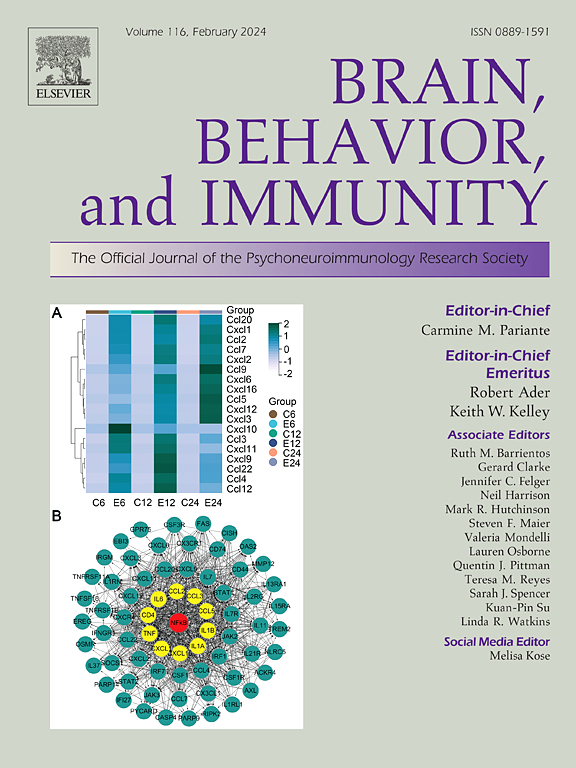在人的一生中,肽聚糖会在不同的大脑区域和细胞类型中积累,但在新生儿中却不存在。
IF 7.6
2区 医学
Q1 IMMUNOLOGY
引用次数: 0
摘要
肽聚糖(PGN)是一种大型复杂聚合物,对所有细菌物种的结构和功能至关重要。完整的 PGN 及其片段具有炎症性,可导致感染性和自身免疫性疾病。最近的研究表明,PGN 在生理上有助于免疫设置点,而且对小鼠的大脑发育和行为也有重要影响。然而,对于人脑而言,PGN 及其片段是否会以不同方式进入不同的脑区、哪些细胞类型会积聚 PGN 以及 PGN 的脑负荷是否会随年龄而变化,这些问题仍然不得而知。因此,我们研究了从新生儿到高龄老人等不同年龄段供体的人脑死后样本。我们检测了两种针对 PGN 的单克隆抗体,并通过点印迹分析、竞争分析和细菌囊免疫荧光实验对其进行了验证,结果显示这两种抗体都能特异性地检测到革兰氏阳性 PGN。作为阳性参考组织,脓毒症患者的脑组织和人体肝脏都显示出预期的高 PGN 水平。在不同年龄(34 至 94 岁)和性别的成人脑组织中,我们在七个不同的脑区检测到了 PGN 信号,其中枕叶皮层、海马形成、额叶皮层、脑室周围和嗅球的 PGN 信号量最高。通过显微镜观察,信号的增加与年龄的关系并不明显,而且通过统计分析,在该组人群中也只发现了微弱的相关性。在星形胶质细胞、少突胶质细胞、神经元和内皮细胞中,PGN 存在于细胞核周围的细胞质中,但不存在于巨噬细胞(如小胶质细胞)中。三例人类新生儿(死产至四周大)的脑组织中没有 PGN。为了进行比较,对不同年龄(从新生儿到 21 岁)的非人灵长类动物的三个脑区进行了免疫组化染色。在 18 至 21 岁猕猴的脑组织中观察到最高的 PGN 含量。这是对人类死后大脑中 PGN 的首次系统性评估,表明 PGN 在人的一生中会不断积累,直到通过同源性周转达到一个平衡点,并强调了 PGN 在人类脑组织中的普遍存在,以及它们在人的一生中参与生理和病理过程的能力。本文章由计算机程序翻译,如有差异,请以英文原文为准。
Peptidoglycan accumulates in distinct brain regions and cell types over lifetime but is absent in newborns
Peptidoglycan (PGN) is a large complex polymer critical to structure and function of all bacterial species. Intact PGN and its fragments are inflammatory, contributing to infectious and autoimmune disease. Recent studies show that PGN physiologically contributes to immune setpoints, and importantly also to mouse brain development and behavior. However, for the human brain, it remains unknown whether PGN and its fragments differentially gain access to distinct brain regions, which cell types accumulate it, and whether PGN brain load varies with age. Therefore, we investigated human postmortem brain samples of donors with an extensive age range, from newborns to nonagenarians. We examined two monoclonal antibodies against PGN which were validated using dot blot analysis, competition assays and immunofluorescence experiments on bacteria sacculi, which jointly showed specific detection of Gram-positive PGN. As positive reference tissue, brain tissue from sepsis patients, and human liver were used, both showing the expected high PGN levels. In adult brain tissue of different age (34- to 94-year-old) and sex, we detected PGN signals in seven different brain regions, with highest loads in the occipital cortex, hippocampal formation, frontal cortex, the periventricular region and the olfactory bulb. Age-dependent increase of signals was not evident by microscopic observations and only weak correlation was found by statistical analysis in this cohort. PGN was found intracellularly in the cytoplasm surrounding the cell nucleus in astrocytes, oligodendrocytes, neurons, and endothelial cells, but not in macrophages like microglia. PGN was absent in brain tissues of three human newborns (stillbirth to four weeks old). For comparison, three brain regions from non-human primates of varying age (newborn to 21 years) were immunohistochemically stained. The highest PGN-load was observed in brain tissue from 18- to 21-year-old macaques.
This first systematic evaluation of PGN in human postmortem brain suggests that PGN accumulates during lifetime until it reaches a plateau by homeostatic turnover and highlights the ubiquitous presence of PGN in human brain tissues, and their ability to participate in physiological as well as pathological processes throughout life.
求助全文
通过发布文献求助,成功后即可免费获取论文全文。
去求助
来源期刊
CiteScore
29.60
自引率
2.00%
发文量
290
审稿时长
28 days
期刊介绍:
Established in 1987, Brain, Behavior, and Immunity proudly serves as the official journal of the Psychoneuroimmunology Research Society (PNIRS). This pioneering journal is dedicated to publishing peer-reviewed basic, experimental, and clinical studies that explore the intricate interactions among behavioral, neural, endocrine, and immune systems in both humans and animals.
As an international and interdisciplinary platform, Brain, Behavior, and Immunity focuses on original research spanning neuroscience, immunology, integrative physiology, behavioral biology, psychiatry, psychology, and clinical medicine. The journal is inclusive of research conducted at various levels, including molecular, cellular, social, and whole organism perspectives. With a commitment to efficiency, the journal facilitates online submission and review, ensuring timely publication of experimental results. Manuscripts typically undergo peer review and are returned to authors within 30 days of submission. It's worth noting that Brain, Behavior, and Immunity, published eight times a year, does not impose submission fees or page charges, fostering an open and accessible platform for scientific discourse.

 求助内容:
求助内容: 应助结果提醒方式:
应助结果提醒方式:


